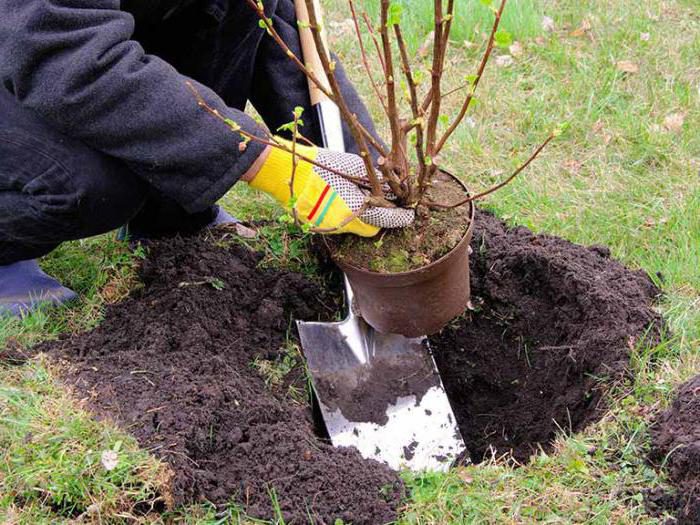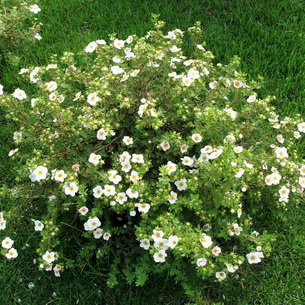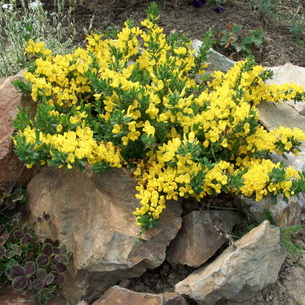Planting Potentilla

Almost all representatives of this genus are distinguished by their undemanding growing conditions, with the exception of Shiny Potentilla, which is recommended to be grown in the southern exposure, choosing dry sandy soil for it, as well as White Potentilla - it likes to grow in a shaded place. For the remaining species, they are best suited to well-lit areas that should be shaded in the afternoon with other plants. The soil they need is slightly acidic, loose, saturated with nutrients, and also well-drained, which has a little lime in its composition. It should be remembered that the Arctic Potentilla needs acidic soil.
How to grow herbaceous cinquefoil from seeds
Cinquefoil can be propagated by various methods, for example, grown from seeds. Experts advise sowing directly into open soil in autumn. In winter, such seeds undergo natural stratification, due to which in spring they give amicable shoots and they only need to be planted. Sowing can be done outdoors and in spring. However, a more reliable way is to grow through seedlings. To do this, sowing seeds should be done in February or March, while the container must be covered with a film before the first shoots appear and removed to a place with a temperature of 15 to 18 degrees. After real leaf blades grow at the seedlings, they are picked in peat-distilled or individual cups. The growth of seedlings is relatively slow, but already at the end of the summer period, the seedlings can be transplanted to a permanent place in open soil. Young plants will need shelter to survive the winter. The flowering of cinquefoil grown from seeds is observed only in the second year. These plants reproduce well by self-sowing.
How to plant shrub cinquefoil

In early spring, after the snow cover melts, and the soil warms up a little, you should start planting shrub seedlings. The width and depth of the pit should be a couple of times larger than a clod of earth or a container in which the seedling grows. If you are planting several bushes, then remember that the distance between them should be 0.3 m.A drainage layer should be made at the bottom of the hole; for this, lime gravel is poured into it. Then the ½ part hole should be filled with soil mixture, which includes leaf earth, humus and sand (2: 2: 1), and 150 grams of complex mineral fertilizer must be added to it. When placing a seedling in a planting hole, it should be noted that its root collar should rise slightly above the soil surface. Then the pit should be filled with soil, which must be well compacted. The planting needs to be watered abundantly. For 20 days, it is necessary to ensure that Potentilla always has a sufficient amount of water. In order to reduce the rate of drying of the soil, it should be sprinkled with a layer of mulch (bark, straw or sawdust). If necessary, then you can plant Potentilla in the last summer or first autumn days.
Shrub cinquefoil
The culture has been known in the world gardening art for more than 300 years. Below in more detail about the types of Potentilla, and how this plant can be useful in the garden.
Origin and appearance
The natural habitat of dazifora is the entire northern hemisphere. However, the areas of its distribution with the differentiation of the climate were divided by territories with arid and hot climates. Currently, the wild variety can be found in the mountainous terrain of Eastern Siberia and the Far East, the Caucasus, Mongolia, China, Japan, and the northern United States.

What does the cinquefoil flower look like?
For your information! American and European breeders have created many hybrid forms of Potentilla with a variety of flower colors, heights and the degree of spreading of the bushes.
The variety most commonly found in nature is yellow cinquefoil, which is a shrub that varies widely in height - from 10 to 150 cm. Branches can have a vertical or almost horizontal growth pattern. The bark on the trunk and old branches exfoliates, it is brownish-gray or red-brown, young branches are covered with hairs in the form of a pile. Leaves up to 3 cm long can be light or dark green, they are fleecy-hairy and collected in the form of complex feathers of 3-5 pcs.
Potentilla flowers are formed at the ends of the shoots of the current year, single or collected in groups from 2 to 7 pieces, have five whole petals. The middle of the flower is fluffy due to the large number of stamens (30 or more). Due to the large number of shoots, the bushes look abundantly flowering.
Note! Fruits in the form of small brown achene berries can stay on the bush for a long time
Flowering duration
An almost unique in nature positive property of Cinquefoil as an ornamental plant is long, abundant flowering. In the conditions of the Central Region, the growing season begins in the second decade of April. The growth of young shoots is activated in mid-May and continues until September. All this time, buds are formed on them.
The first flowers of the five-leafed bush can be seen in the second half of June. Duration of flowering is 2.5-4 months.
Nepalese and Mongolian traditional medicine widely uses dazifora in the form of decoctions and infusions for the treatment of diseases of the stomach and intestines. The property of the extract was found to normalize the emotional state, improve muscle tone, cause anti-inflammatory, hemostatic and diuretic effect.
For your information! Kuril tea has the ability to increase the body's immunity, it is not without reason that it is also called "mighty". However, before using it, you should familiarize yourself with the contraindications.
The use of shrub Potentilla in landscape design
Due to the variety of varieties with different patterns of shoot growth and color of flowers, the cinquefoil shrub is used in landscape design in the form of the following elements:

Potentilla hedge
- solo (main) component of the landscape;
- undersized and herbaceous forms - a good ground cover crop in open slopes;
- curb plant;
- hedge;
- alpine slide and rockery.

Rockery with Potentilla
The use of Potentilla in garden design
Both herbaceous and shrubby forms of plants are desirable in any flower bed. Due to its moderate exactingness, rapid growth and willing flowering, Potentilla can be successfully grown in any climatic zone of Russia, the main thing is to choose the right varieties and learn about some general preferences of the culture.
Suitable for Potentilla:
- well-drained, moderately moist soil;
- an area in the sun or in a light shade, where the plant is not at risk of flooding and decay;
- flowerbed, curb or rabatka in urban areas, since the plant is not afraid of smoke and high concentration of dust and exhaust gases in the air.
All types of Potentilla are rarely affected by pests, they winter well, especially with a dry preventive shelter of the root system.
The lack of smell and long-term flowering make it possible to plant shrubs and herbaceous species near children's, educational and medical institutions, in crowded squares and in the courtyards of residential buildings. A variety of varieties, especially the appearance of semi- and terry varieties, guarantees the uniqueness of the landscape design and the pride of the owner of the site.
Cinquefoil (Potentilla) belongs to one of the largest genera in terms of the number of species, which is part of the pink family. Its bright representatives are considered to be erect cinquefoil (galangal-grass) and cinquefoil goose.Most of the species of this genus in natural conditions can be found in the Northern Hemisphere. Cinquefoil comes from the Latin word "potent" - "powerful, strong." Apparently, this refers to the incredible healing power of individual representatives of this kind. All over the world, there are about 500 species of Potentilla, which are represented mainly by herbaceous plants, but there are also shrubs among them. At the same time, both grass and shrubs belonging to this genus are cultivated in gardens. The cinquefoil shrub in Russia is called Kuril tea or five-leafed, while there is an old legend that tells about Ilya Muromets, the smell of cinquefoil gave him unprecedented strength. Russian healers also call cinquefoil a mighty man, and since ancient times it has been used to heal a variety of ailments, as well as to restore strength. Today, this plant is mostly used as a decorative plant, and experts plant it on a green lawn as a tapeworm, and they also decorate curbs, alpine slides and hedges with it.
Shrub Kuril tea in landscape design
Cinquefoil (Potentilla) belongs to the Rosaceae family. Her homeland is temperate and cold regions of the planet.
Cinquefoil, she is potentilla, she is dazifora, is part of the Rosaceae family. The genus includes about 500 species of annual and perennial herbaceous plants with a similar habit, common in the temperate and arctic regions of the Northern Hemisphere. This dwarf plant has characteristic dissected leaves, which most likely served as the starting point for the name.
Kuril tea has been grown in the gardens for about 300 years. The most valuable quality of a plant is the ability to bloom without interruption all summer, from June to September. Even in late September - early October, when there are no other flowering shrubs left, Kuril tea continues to bloom like a miniature non-double rose flowers. In wild species, as well as in many garden forms of Kuril tea, flowers are yellow, but there are also white, orange, and even red flowers.
In cold winters, numerous shoots freeze over, but the bush persists. Most often, there are decorative forms and varieties of Kuril shrub tea, or shrub five-leaf tea. These low-growing plants (from 0.5 to 1.5 m) are most suitable for rocky gardens, rock gardens, hedges and small compositions with perennials, low yews, junipers, thujas.
Pay attention to the photo of Potentilla - the plants grow rapidly in breadth:


The crown of an adult Kuril tea is dense and shaped like a pillow. Recommended for landscaping slopes and rocky hills. For the cultivation of Kuril tea in landscape design, many hybrid forms have been bred.
The shrub is good in clean and mixed group plantings, for the device of low hedges and borders. Looks beautiful in rock gardens, on rocky areas and alpine slides.
As you can see in the photo, Potentilla (Kuril tea) in many respects is ideal for decorating rocky gardens, especially large ones:


The plant is unpretentious to the soil and winter hardy; in addition, it has active growth, due to which it quickly fills open spaces with itself. Potentilla looks especially impressive against the background of conifers. And it is in this combination that it is recommended for a Japanese-style garden.
The following is a botanical description of Potentilla and recommendations for its cultivation in the garden.
Reproduction methods
There are 5 ways to reproduce Potentilla:
- For propagation by seeds directly into the ground, mid-May is best suited. The soil should be light and nutritious.
- Seedlings are grown from seeds that are sown in a special container.
- For dividing by cuttings, a 10 cm long branch is cut off from an adult bush.The lower part of the planting material is processed by "Kornevin" and planted in a special pit filled with drainage.
- Layers. The lower branch of the bush is gently laid aside and buried in. The offspring should be in the most nutritious and moist soil.
- Only an adult plant can be divided. The bush is dug up, the root system is divided into the required number of parts.


